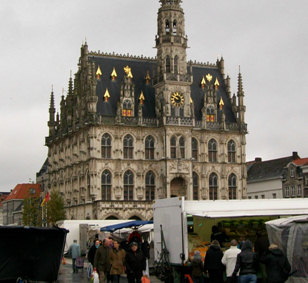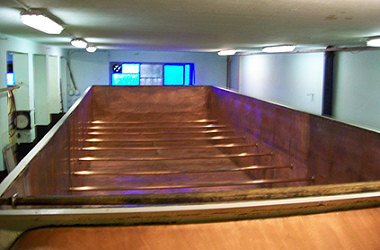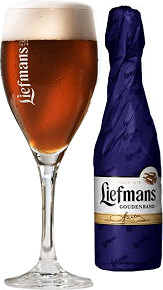 |

|
|

|
|
|
 |

home
about
features
A-Z
books

|

|

features
|

| |
Belgium Part I - Liefmans
by Willard Clarke, 11/09
The hand of history lies heavily on the beers of Belgium. Over the centuries it has been over-run by the French, the Dutch, the Germans and the Spanish, and these nations have all influenced the
course of Belgian brewing. Nowhere is that influence more keenly felt than in the small but architecturally impressive town of Oudenaarde.
| The town in East Flanders is famous for its tapestries, silverware and Gothic town hall (right). Beer is part of the tapestry of its history. A fountain in the market place was donated by the French king
Louis XIV and during an annual beer festival in June the fountain gushes beer, not water.
Oudenaarde is divided by the River Schelde. It's the river that has determined the course of brewing in Oudenaarde. At one time it marked the dividing line between the French and German empires.
In the 14th century, breweries on the German side, in the Duchy of Brabant, were forced to use hops in their beer. |
|
 |
Producers on the left bank controlled by the French, however, were banned from
using hops and had to use a mixture of herb and spices, known as gruut in Dutch. Following the French Revolution brewing was banned for a while as the revolutionaries believed all brewers
were hated freemasons. The ban was eventually lifted by Napoleon.
the Oudenaarde secret
All the breweries in Oudenaarde had one thing in common: the local water from many small springs 100 metres deep. The water has a high level of sodium bi-carbonate that makes it best suited for
producing brown beer. As a result, the town is renowned for a style known as Oud Bruin - Old Brown. Oudenaarde was once packed with breweries and an official tour of the town takes in many closed
plants. Eight survived until the 1950s but today only three breweries remain. Liefmans is by far the best known due to its presence in international markets, though the Roman
brewery is considerably bigger. Cnudde, a tiny family-owned company, brews part time and has financial support from Roman.
The two main breweries reflect the history of the region. Roman's brown beer has a good hoppy edge, while Liefman's is far less bitter but has a lactic sourness reminiscent of the "sour red" beers of
neighbouring West Flanders.
Liefmans
Liefmans was founded in 1679 and was based in the centre of Oudenaarde until it moved to its present site on the banks of the Schelde in 1933. In the 1970s and 80s, Liefmans achieved a greater
public profile thanks to the tireless work of its manager, Rose Blancquaert-Merckx, a former ballet dancer. "Madame Rose" eventually retired from the brewery to run a restaurant in the town that
featured the local dish carbonade flamande - beef stewed cooked with Oud Bruin. The brewery was bought in 1991 by the Riva group based in Dentergem just over the border in West Flanders.
Riva began the process of producing wort at Dentergem that was trunked to Liefmans for fermenting, conditioning, bottling and storage.
 |
|
The reason was two-fold: Liefmans has an idiosyncratic
design that includes small mash tuns that are of insufficient size to feed large boiling kettles. In turn, the hopped wort was then fermented in two enormous open fermenters (left), one of
which can hold 450 hectolitres of beer. Secondly, the mash tuns and kettles were old, creaking and leaking at the seams and would have needed major investment to bring them up to date.
|
In 2007 Riva was declared bankrupt and production at Liefmans stopped. It seemed that Belgium would lose its most famous brewer of Oud Bruin. But a year later it was bought by Duvel Moortgat in
Breendonk and production has started once more in Oudenaarde. Moortgat is best known for its strong golden ale, Duvel, so famous that its name is now incorporated in to the title of the company.
Hopped wort is made at Breendonk and transported to Oudenaarde. Once again, the reason given is that too much cash would be needed to refurbish the mash tuns and kettles at Liefmans. Moortgat's
highly flexible plant can produce 30 brews a week while Liefmans, with its vast fermenting capacity, needs just one brew each week. It therefore makes economic if not aesthetic sense to start the
brewing process at Breendonk. Moortgat is adamant on one point: it will not ferment Liefman's beer in its main brewery as it doesn't want to run the risk of the Oudenaarde yeast culture infecting
its own beers.
It's the Liefman's yeast strain that gives the beers their unique character and lactic sourness. The character has developed over the centuries and has many contributors: the local water, extremely
low ceilings in the fermenting room that impact on temperature, and help from wild yeasts and other flora in the atmosphere. The yeast came originally from the Rodenbach brewery in West Flanders,
famous for its "sour red" beer.
| The russet/brown beers are made with three malts: Pilsner, caramalt and roasted grain. The hops used to be Czech Saaz and English Goldings but are now all Belgian varieties. Units of bitterness are
extremely low, around 10, as hop bitterness doesn't marry well with the sourness of the finished beer.
Following a week-long fermentation, the beer is conditioned in a warm cellar, then cold conditioned for two weeks prior to blending. All the beers are a blend of young and mature beers. The core
range is Oud Bruin (5%), Goudenband (8%) and Kriek (4.2%). Goudenband means Gold Riband and is a blend of fresh and aged beers - the young beer is between three and four months' old while the aged
version will enjoy a year or more in the cellar. Kriek is a fruit beer made with the addition of cherries. The beer again is a blend and the aged version will stay in tank for a year. A special
version of kriek, Cuvée Brut (6%), is produced as an annual vintage and uses a proportion of beer that has been aged for as long as three years.
|
|
 |
|
|
home
about
features
A-Z
books
|

